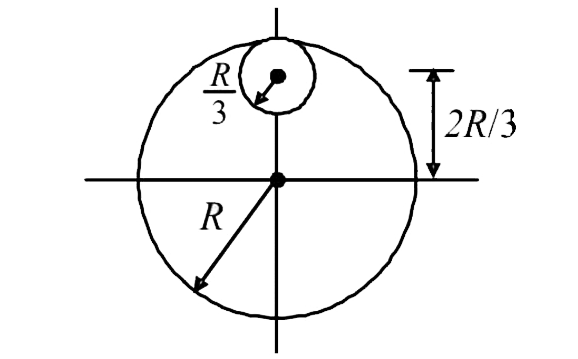From a disc of mass m and radius r, a circular portion of radius r3 is removed from the edges. Find the M.O.I of the remaining system about a normal through center of original discSolution in Telugu
Let I2 be the M.I. of remaining poriton.
M.I of the removed partion about a normal axis through centre of the original disc is
I1=m9(r3)22+m9(2r3)2 or I1=mr218
Hence, M.I. of the remaining portion is
I2=I−I1=mr22−mr218 or I2−4mr29
Topper's Solved these Questions
- SYSTEM OF PARTICLES AND ROTATIONAL MOTIONBOOK - AAKASH SERIESCHAPTER - SYSTEM OF PARTICLES AND ROTATIONAL MOTIONEXERCISE - EXERCISE - 1A
120 Videos
- SYSTEM OF PARTICLES AND ROTATIONAL MOTIONBOOK - AAKASH SERIESCHAPTER - SYSTEM OF PARTICLES AND ROTATIONAL MOTIONEXERCISE - EXERCISE - 1B
51 Videos
- SURFACE TENSIONBOOK - AAKASH SERIESCHAPTER - SURFACE TENSIONEXERCISE - ADDITIONAL PRACTICE EXERCISE (PRACTICE SHEET (ADVANCED) INTEGER TYPE QUESTIONS )
8 Videos
- THERMAL PROPERTIES OF MATTERBOOK - AAKASH SERIESCHAPTER - THERMAL PROPERTIES OF MATTEREXERCISE - ADDITIONAL PRACTICE EXERCISE (LEVEL - II) PRACTICE SHEET (ADVANCED) Integer/Subjective Type Questions
2 Videos
Similar Questions
Three identical spheres each of radius R are placed touching each other on a horizontal table. The centre of mass of the system is located
View Solution(A) : Position of centre of mass of a body (w.r.t body frame) is independent of co-ordinate system.
(R ) : Internal forces do not effect the motion of centre of mass.
View SolutionIf the work done in blowing a soap bubble of volume 'V' is W, then the work done in blowing a soap bubble of volume '2V' is
View SolutionA constant pressure gas thermometer has a volume of 200cc, 273.2cc and 525 .1cc at 0°C, 100°C and boiling point of sulphur respectively. The resistance possessed by a platinum wire at the same temperatures as above are 2.000Ω,2.778Ωand5.280Ω respectively. Estimate the boiling point of sulphur on the basis of the two sets of observations.
View SolutionFrom a disc of radius r_(1) , a concentric disc of radius r_(2) is removed . The mass of the remaining portion is m . Find the M.I. of the remaining about an axis passing through the center of mass and perpendicular to the plane.
View SolutionFrom a circular disc of mass M and radius R , a part of 60^(@) is removed. The M.I. of the remaining portion of disc about an axis passing through the center and perpendicular to plane of disc is
View SolutionFrom a circular disc of radius R , another disc of diameter R is removed. Locate c.m. of the remaining portion.
View SolutionA circular disc of radius R is removed from a bigger circular disc of radius 2 R such that the circumferences of the discs coincide. The center of mass of new disc is alpha R from the center of the bigger disc. The value of alpha is
View SolutionFrom a circular disc of radius R and mass 9M, a small disc of radius R/3 is removed as shown in figure. The moment of inertia of the remaining disc about an axis perpendicular to the plane of the disc and passing through O is

View SolutionA disc of radius r is removed from the centre of a disc of mass M and radius R. The M.I. About the axis through the centre and normal to the plane will be:
View SolutionFrom a circular disc of radius R and 9M , a small disc of mass M and radius R3 is removed concentrically .The moment of inertia of the remaining disc about and axis perpendicular to the plane of the disc and passing through its centre is
View SolutionFrom a uniform disc of radius R, a small disc of radius (R)/(2) is cut and removed as shown in the diagram. Find the center of mass of the remaining portion of the disc.
View SolutionFrom a circular disc of radius R and mass 9 M , a small disc of radius R/3 is removed from the disc. The moment of inertia of the remaining disc about an axis perpendicular to the plane of the disc and passing through O is

View SolutionFrom a disc of mass m and radius r, a circular portion of radius r3 is removed from the edges. Find the M.O.I of the remaining system about a normal through center of original disc
View SolutionFrom a circular disc of radius R and mass 9M, a small disc of radius R/3 is removed as shown in figure. The moment of inertia of the remaining disc about an axis perpendicular to the plane of the disc and passing through O is
View Solution